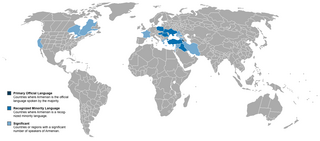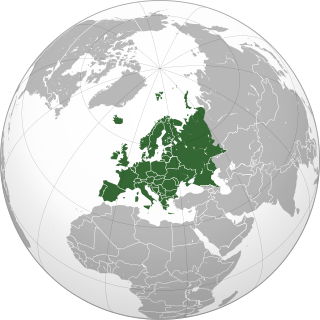
Saint Gregory the Illuminator is the patron saint and first official head of the Armenian Apostolic Church. He was a religious leader who is credited with converting Armenia from paganism to Christianity in 301. Armenia thus became the first nation to adopt Christianity as its official religion.
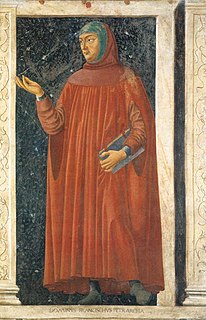
The "Dark Ages" is a historical periodization traditionally referring to the Middle Ages, that asserts that a demographic, cultural, and economic deterioration occurred in Western Europe following the decline of the Roman Empire.
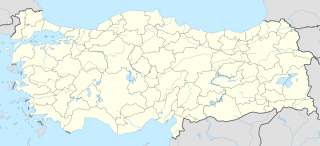
Kozan is a city in Adana Province, Turkey, 68 kilometres northeast of Adana, in the northern section of the Çukurova plain. The city is the capital of the ilçe (district) of Kozan. The Kilgen River, a tributary of the Ceyhan, flows through Kozan and crosses the plain south into the Mediterranean. The Taurus Mountains rise up sharply behind the town.

The Armenian Apostolic Church is the national church of the Armenian people. Part of Oriental Orthodoxy, it is one of the most ancient Christian communities. The Kingdom of Armenia was the first state to adopt Christianity as its official religion under the rule of King Tiridates in the early 4th century. The church originated in the missions of Apostles Bartholomew and Thaddeus in the 1st century, according to tradition.

The Armenian Catholic Church, also referred to as the Armenian Uniate Church, is one of the Eastern particular churches sui iuris of the Catholic Church. They accept the leadership of the Bishop of Rome, known as the papal primacy, and therefore are in full communion with the Catholic Church, including both the Latin Church and the 22 other Eastern Catholic Churches. The Armenian Catholic Church is regulated by Eastern canon law, namely the Code of Canons of the Eastern Churches.
Raymond-Roupen was a member of the House of Poitiers who claimed the thrones of the Principality of Antioch and Armenian Kingdom of Cilicia. His succession in Antioch was prevented by his paternal uncle Bohemond IV, but his maternal granduncle Leo I of Cilicia recognized him as heir presumptive to Cilicia and pressed his claim to Antioch. In 1211 Raymond-Roupen was crowned junior king of Cilicia, and was finally installed as Prince of Antioch in 1216. The War of the Antiochene Succession ended with Leo's death in 1219, shortly before Raymond-Roupen was ousted from Antioch. He then pursued his claim to Cilicia, which Leo had unexpectedly willed to his daughter Isabella on his deathbed, but was defeated and imprisoned until death.

San Lazzaro degli Armeni is a small island in the Venetian Lagoon which has been home to the monastery of the Mekhitarists, an Armenian Catholic congregation, since 1717. It is the primary center of the Mekhitarists, while the Mekhitarist Monastery of Vienna is their primary abbey.

The Armenian Kingdom of Cilicia, also known as the Cilician Armenia, Lesser Armenia, or New Armenia, was an independent principality formed during the High Middle Ages by Armenian refugees fleeing the Seljuq invasion of Armenia. Located outside the Armenian Highland and distinct from the Armenian Kingdom of antiquity, it was centered in the Cilicia region northwest of the Gulf of Alexandretta.

Isabella I, also Isabel I or Zabel I, was the queen regnant of Cilician Armenia (1219–1252).

Kahramanmaraş is a city in the Mediterranean Region of Turkey and the administrative center of Kahramanmaraş Province. Before 1973, Kahramanmaraş was named Maraş. The city lies on a plain at the foot of the Ahir Dağı and has a population of 1,112,634 as of 2017. The region is best known for its distinctive ice cream, and its production of salep, a powder made from dried orchid tubers. It is connected by air to Istanbul and Ankara. Turkish Airlines has daily direct flights from İstanbul and also AnadoluJet operates direct flights from Ankara.

Kirakos Gandzaketsi was an Armenian historian of the 13th century and author of the History of Armenia, a summary of events from the 4th to the 12th century and a detailed description of the events of his own days. The work concentrates primarily on the history of Medieval Armenia and events occurring in the Caucasus and Near East. The work serves as a primary source for the study of the Mongol invasions and even contains the first recorded word list of the Mongolian language. The work has been translated into several languages including Latin, French and Russian.
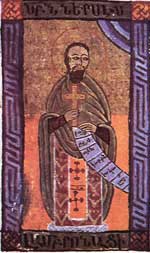
Saint Nerses of Lambron (1153–1198) was the Archbishop of Tarsus in the Armenian Kingdom of Cilicia who is remembered as one of the most significant figures in Armenian literature and ecclesiastical history.
Apkar Tebir was an Armenian colonist and priest. He was one of the first to set up a printing press in Constantinople.

Hayton of Corycus was a medieval Armenian nobleman, monk and historiographer.

Sempad the Constable (1208–1276) was a noble in Cilician Armenia, an older brother of King Hetoum I. He was an important figure in Cilicia, acting as a diplomat, judge, and military officer, holding the title of Constable or Sparapet, supreme commander of the Armenian armed forces. He was also a writer and translator, especially known for providing translations of various legal codes, and the creation of an important account of Cilician history, the Chronique du Royaume de Petite Armenie. He organized and fought in multiple battles, such as the Battle of Mari, and was trusted by his brother King Hetoum to be a key negotiator with the Mongol Empire.

Armenians in Italy covers the Armenians who live in Italy. There are currently 2,500-3,500 Armenians in Italy mainly residing in Milan, Rome and Venice; another main centre of Armenian culture and history is Padua.

Sis was the capital of the Armenian Kingdom of Cilicia. The massive fortified complex is just to the southwest of the modern Turkish town of Kozan in Adana Province.

Mongol Armenia or Ilkhanid Armenia refers to the period in which both Armenia and the Armenian Kingdom of Cilicia became tributary and vassal to the Mongol Empire in the 1230s. Armenia and Cilicia remained under Mongol influence until around 1335.


